Orange Collective

Art Anthropology of Oranges and Humans (Part 3)
-After the “Mikan Mandala” Exhibition-
(3) Symbiosis with Fungi / Mycorrhizal Network
Located near the Minakata Kumagusu Archives, the old folk house atelier called “Mojike House” is operated by artists Naoko Kimura and Shiro Kimura. The adjoining building, SOUZOU (formerly Iwahashi’s house), a newly opened cafe-artspace, displayed art works related to fungi and their networks, utilizing the whole space, with indoors, garden and storehouse with rich vegetation. Such an environment allowed us to see the relationship with “plants” as seen by several Southeastern Asian artists. The theme was something Kumagusu spent his whole life exploring.
It is said that the world of fungi, which we cannot observe with the naked eye, spreads as intricately as the roots of plants underground, and the presence of fungi is essential in creating rich forests. By replacing the macro view (the wide world in which we live) with the perspective of the micro (the small world of fungi), we may be able to glimpse the true complexity of the world.

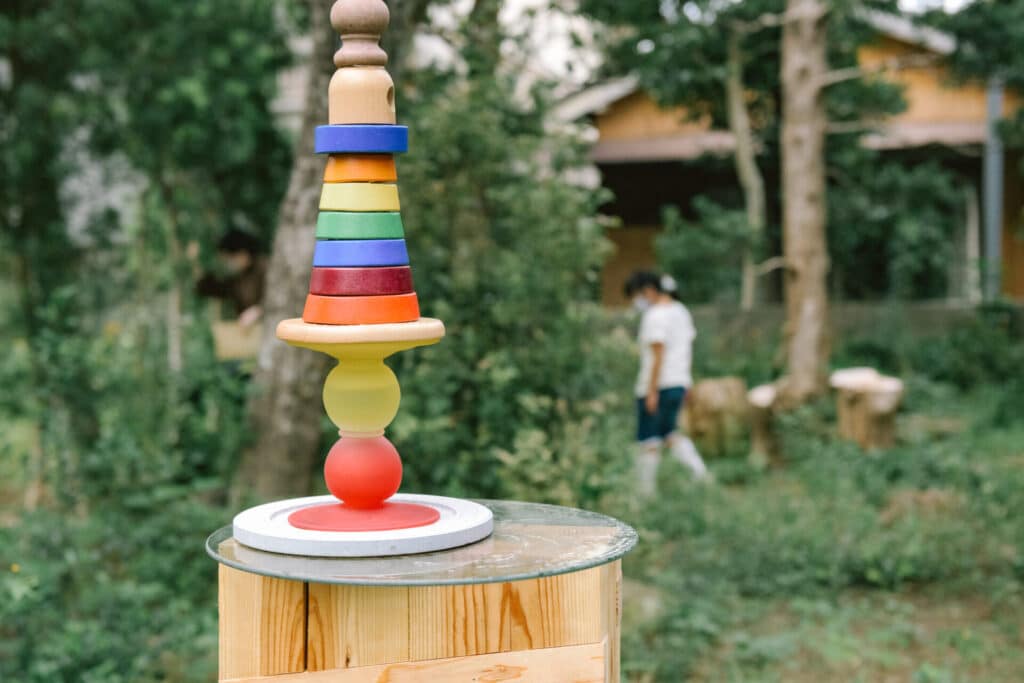
Kano’s “Perpendicularity (Sculpture and Vase)” is exhibited in the SOUZOU garden, where a variety of plants coexist, and is created by incorporating the transformation in the natural environment which opens your eyes to relationships between things. Pjotr Kropotkin (1842-1921), a Russian political philosopher, through his observations of wildlife in Siberia, found that in fact organisms are not strongest in competing against one another, but rather, species that voluntarily build symbiotic relationships to help each other survive by supporting each other’s points of success. Based on his argument, pointing out the fact that species that have been so constructed are successful in surviving, he termed the principle of social formation based on cooperative relationships “mutual aid” [Mori 2017: 161-162]. Strong people such as nations and people in positions of power tend to create vertical monuments to leave their imprint. However, Kano’s “Perpendicularity” seems “visually vertical, but philosophically not vertical,” as he rather visualizes a completely different perpendicularity which is slowly built through the slightest overlap of completely different beings.
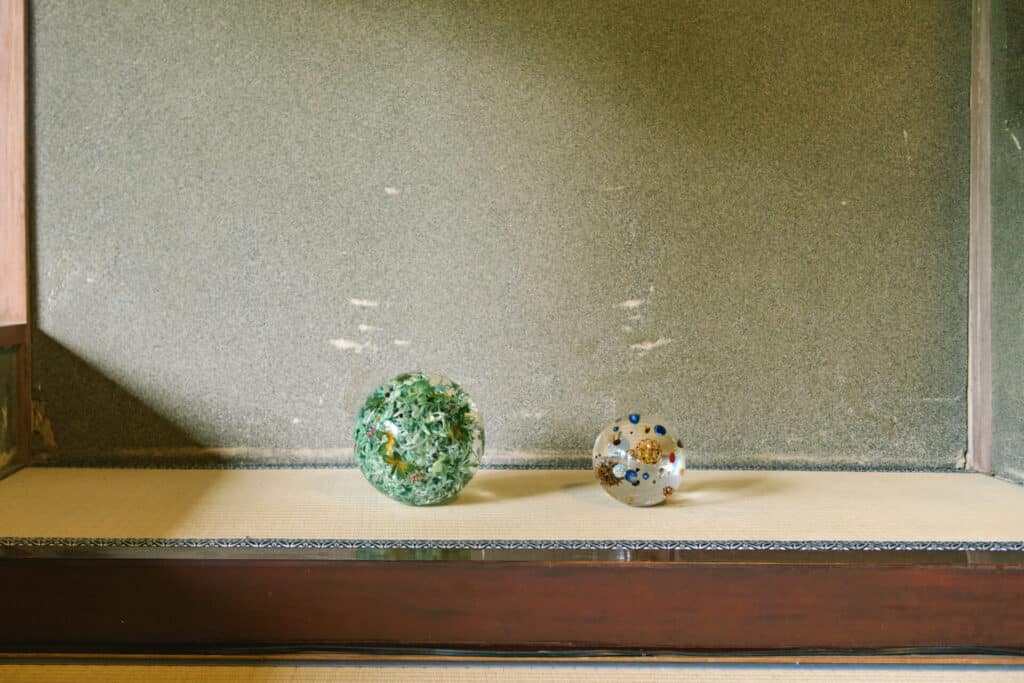
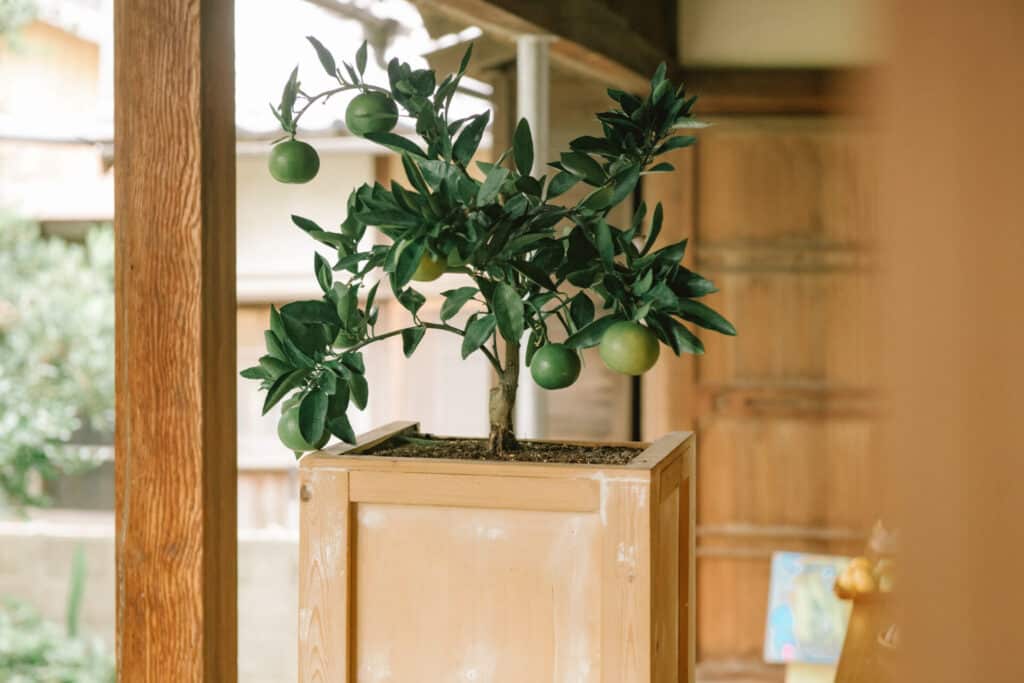
Hirose, who has been discussed previously, focuses his work on foods, such as beans, lemons, as well as common everyday phenomena. He presents works that reaffirm the primordial senses humans have to apprehend the richness of the world.
In “Beans Cosmos”, various things with different “values” such as beans, gold and plants are confined to create a universe-like world. As Coccia noted, plants are in a relationship of “immersing and being immersed in each other” in the transient world via the oxygen created by plants, with respect to humans, animals, soil, etc. [Coccia 2019: reference]. Hirose’s Beans Cosmos is a work through which you can intuitively understand Coccia’s concept. “Fruit Tower”, like “il giardino dei sensi,” is an attempt to exchange the perspectives of plants and humans through his “house” works that creates a house for things other than humans. At SOUZOU, viewers can also grab oranges from “Tower of Fruits” and eat them to engage in a pure gifting experience with oranges.
Thai artist Be Takerng Pattanopas (1965-)’s piece “Within/Without #3” stems from the two notions of inner space and outer space.
Be, who has a benign tumor in his body, uses various media such as sculpture and painting to create many works that raise speculations on the connection between the world inside the human body and the universe. This work was created during the coronavirus crisis, and could look like a collection of cells, slime molds, roots, or perhaps like a universe with countless stars. He imagined the inside of the body in creating this artwork, and I think that it looks like a microcosmos, and seems to evoke the idea of finding common ground with plants, other living things, and the universe, just as Kumagusu conceptualized.

Quynh Dong (1982-) from Vietnam creates video works using elements of performance.
“Late Autumn” is inspired by the movie “Spring, Summer, Fall, Winter and Spring (2003)” directed by Kim Ki-duk (1960-2020), which depicts the life of a man throughout four seasons. The leaves falling in autumn are expressed through multiple female bodies. In a world where there is no sense of space or time, it reminds us that both people and plants are in a big cycle like the circle of transmigration (metephychosis). In addition, you can experience the image of Ingold’s “being alive (participating in the flow of existence without ‘beginning’ or ‘ending’ as its material in the movement of various existences).” Specifically, when a plant bears fruit, we use the word “実が「成る」(miganaru)” in Japanese. In other words, humanity, like plants, can be seen as something that is constantly producing fruit.
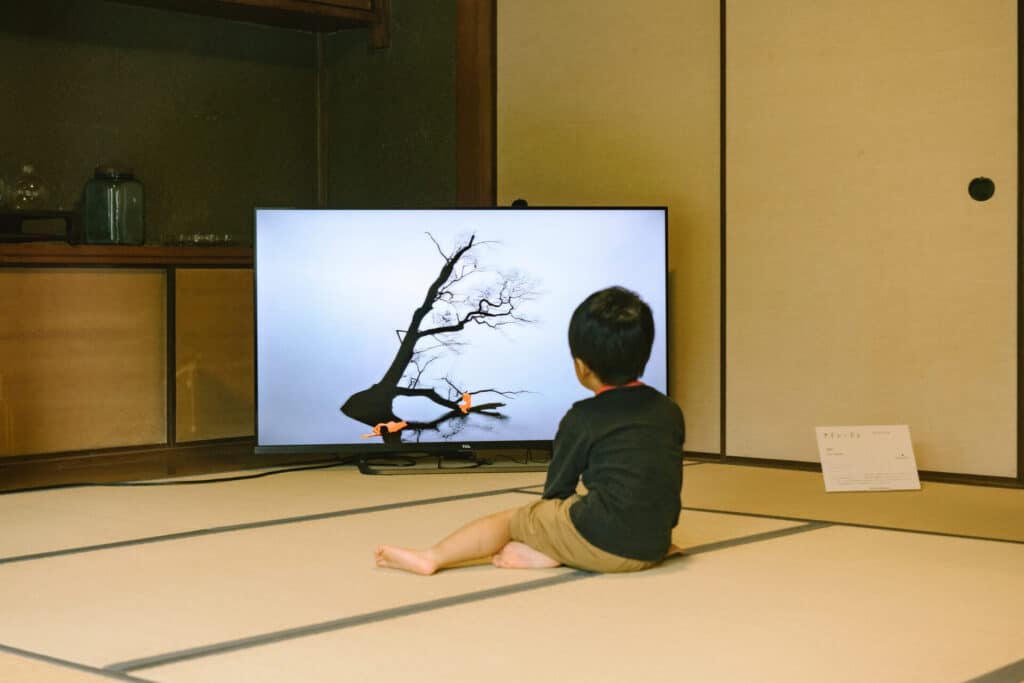
Piyarat Piyapongwiwat (1977-), from Thailand, creates works that emphasize documentation as a way of clarifying and questioning the status and meaning of globalized economic and social-environmental issues. In “Lichen,” fungi mate with algae and live as one entity that can exist even in harsh regions such as Antarctica. In order to recapture the existence of such lichens and slime molds, she and her partner drew lichens with stipple. I think the artist shows that symbiotic relationships generate a fundamentally powerful form of life.
In “Extinct Species”, 10 species of plants that have become extinct from the earth are used as motifs, and the extinct plants are repeatedly depicted in animation format. This also resonates with Ingold’s idea of “being alive.” For example, Ingold refers to a “continuous birth’, that binds into the tapestry of life, the growing and moving organism will be reconfigured as the external manifestation of its inner design. Ingold 2019: 170]”, even if plants have already gone extinct and disappeared, the repeated lines she draws evoke eternal generation, like a cycle of reincarnation. It may be misleading, but for plants that can resurrect from their own carcasses [cf. Vürga 2021:85], going extinct may not be a big deal.
I couldn’t help but intuitively feel that Kumagusu’s fundamental ecological theory is different from modern ecological theories, applied to her art work. In other words, her artwork would not likely be discussed as part of the popular “plant rights theory,” but rather is one that respects plants as possessing a completely different existence. On top of this, her work depicts other living organisms, showing how plants normally engage and mix or interpenetrate with other organisms. Thus, she imagines a close and complicated pluralistic symbiotic relationship between plants to illuminate the “plantness” that humans have.
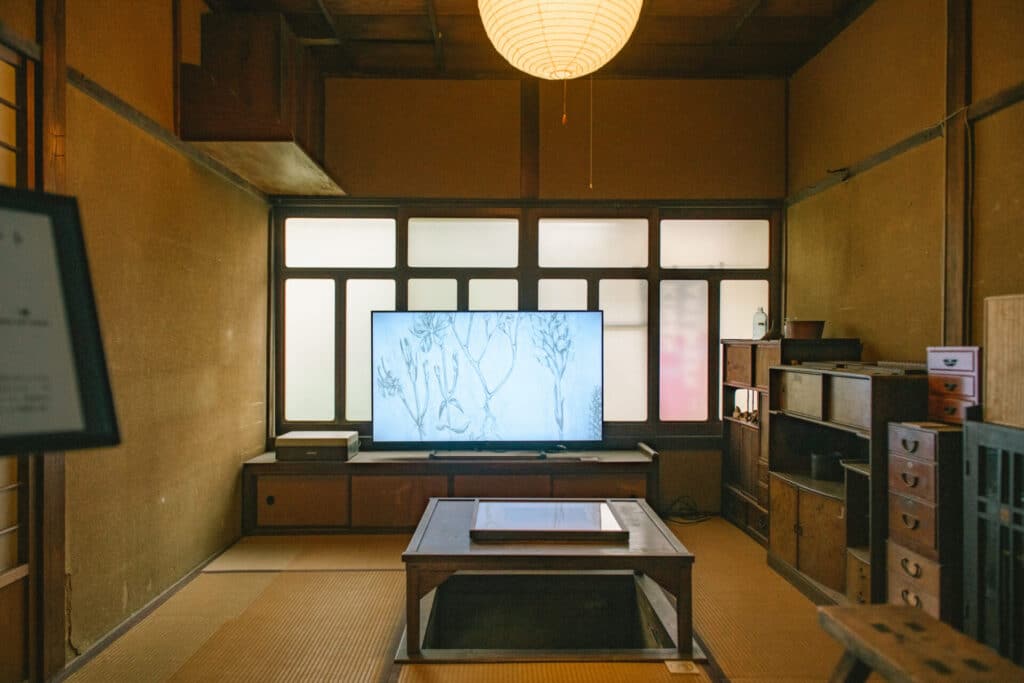
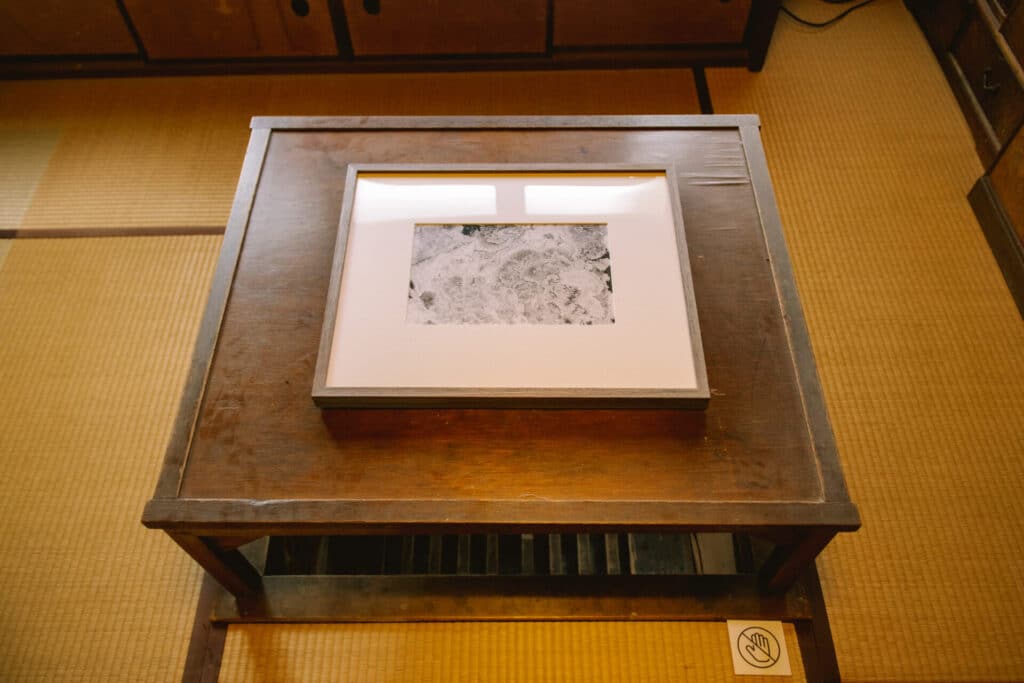
At the SOUZOU storehouse, AWAYA’s “Sound Torus of Mandarins and People” was exhibited.
Awaya is a sound art unit consisting of Masatomo Fukushima and Yumiko Okuno, who live in Nakahechi, Wakayama Prefecture. What kind of sounds do plants, who do not have sensory organs like ears, perceive? In this work, sound recorded in a citrus field is reproduced through citrus branches.
Anatomist Shigeo Miki (1925-1987) said, “The body of a plant is the intestinal tract of an animal that has been pulled out and turned inside out, complete communication” [Miki 1986: 156], the human body and the roots of plants are connected. On this theme, the American geologist David R. Montgomery stated that “plant roots and the human large intestine have the same function, and there are no boundaries here” [Montgomery 2016: 309, 310]. In that sense, even though there is a difference between human organs, which are closed inwards, and plants, which are open to the outside, plants are part of the living ecosystem, and humans may be regarded as “moving plants that take root in the intestines [Fujiwara 2022: 51]”.
This connects with the concept of “external organs” described by anthropologist Toshiaki Ishikura. Through food, the internal organs of the body are opened like a single tube through the mouth and anus. Plants are connected to the world outside the body through their roots, and when the human visceral experience goes beyond the skin and connects with the external environment, the concept of “external organs” can be discovered. [Ishikura, Karasawa 2020: Reference].
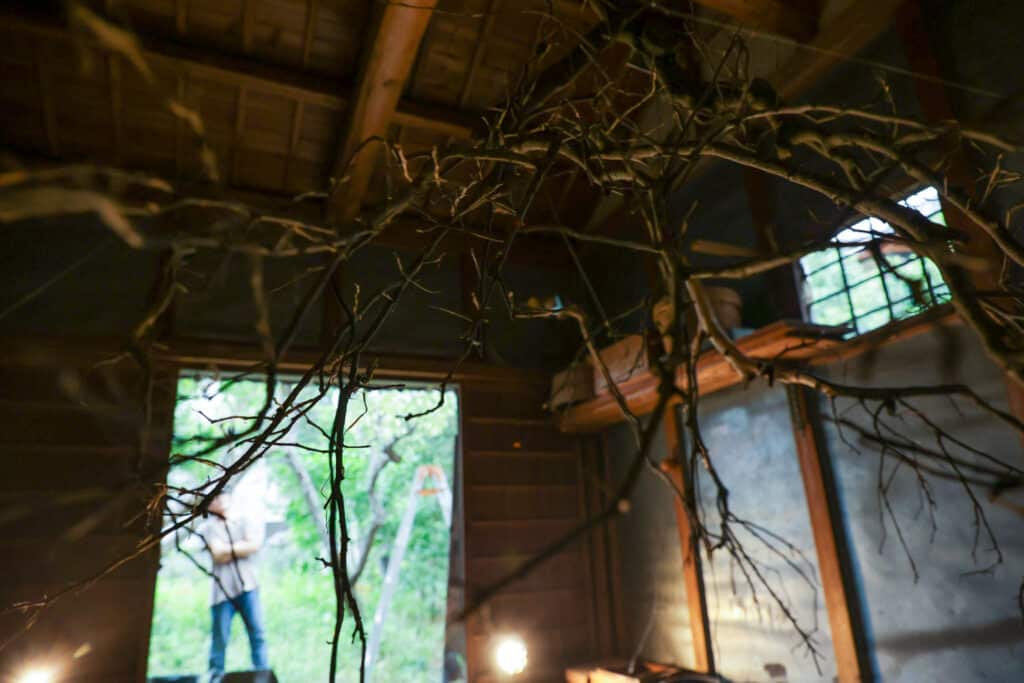
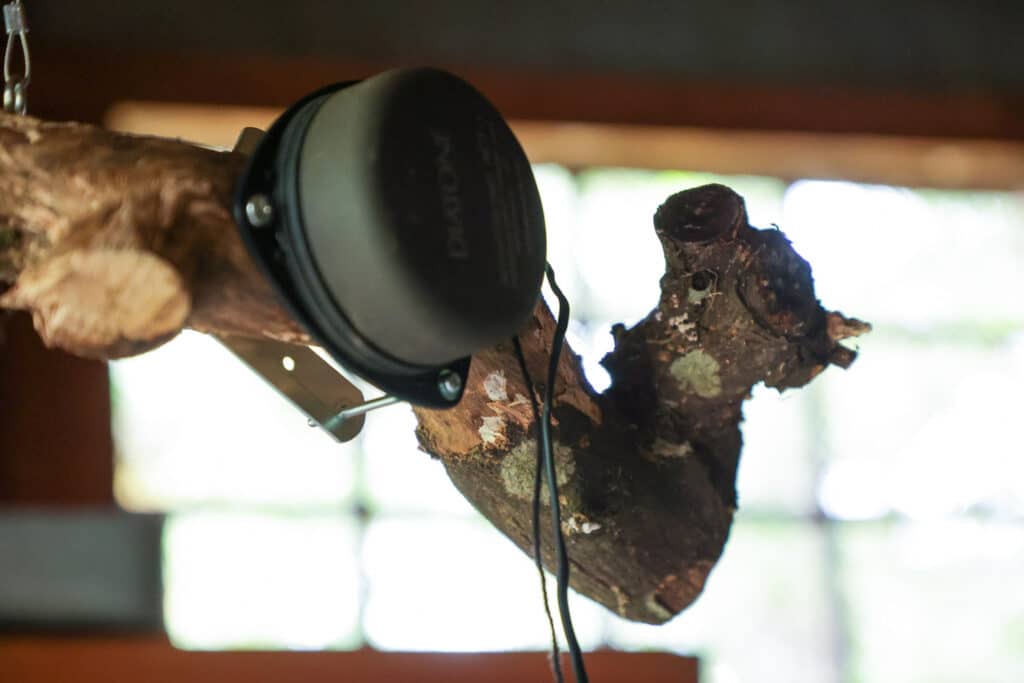
As you can see in the exhibition photo, the branches of the mandarin orange tree are suspended like roots on the ground. When you enter SOUZOU’s warehouse, you will have the illusion that you have entered the Nene no Kuni (the world of the roots). Artist Fukushima has said that he was influenced by Ishikura’s concept of ‘external organs.’ When you put your ear to each branch, you can experience what the mandarin oranges are listening to beyond the physical ‘inside’ and ‘outside storehouse’. It was a new sensory world to enter and experience the hidden “plantness” within oneself.
Vietnamese artist Tuan Mami (1981-) founded the Hanoi-based Nha San Collective (“Nha San” means “home” in the Hmong language). In his work, he observes how we move as ‘humans’. In recent years, Mami has turned his attention to Vietnamese immigrants living in Vietnam, Taiwan, Germany and other parts of the world. “Vietnamese Immigrating Garden No. 2” explores the relationship between Vietnamese immigrants living in Taiwan and native plants that are now difficult to bring into Taiwan. Growing plants is not only about eating, but also about passing on knowledge and culture, as well as forming communities that support life in the places where people have moved.
In this regard, Coccia philosophically explains the meaning of ‘to migrate’ as existing in a place where ‘dwelling’ and ‘being inhabited’ overlap. In other words, organisms are constantly on the move, and living things can become temporary homes for other organisms. All living things are also temporary homes and “vehicles” for other living things [Coccia 2022: 209]. The “Vietnamese Immigrating Garden No. 2, 2022” exhibited at documenta interrogates what plants could be our “home” and “vehicle,” and how sometimes humans could be the plants’ “home” and “vehicle.”
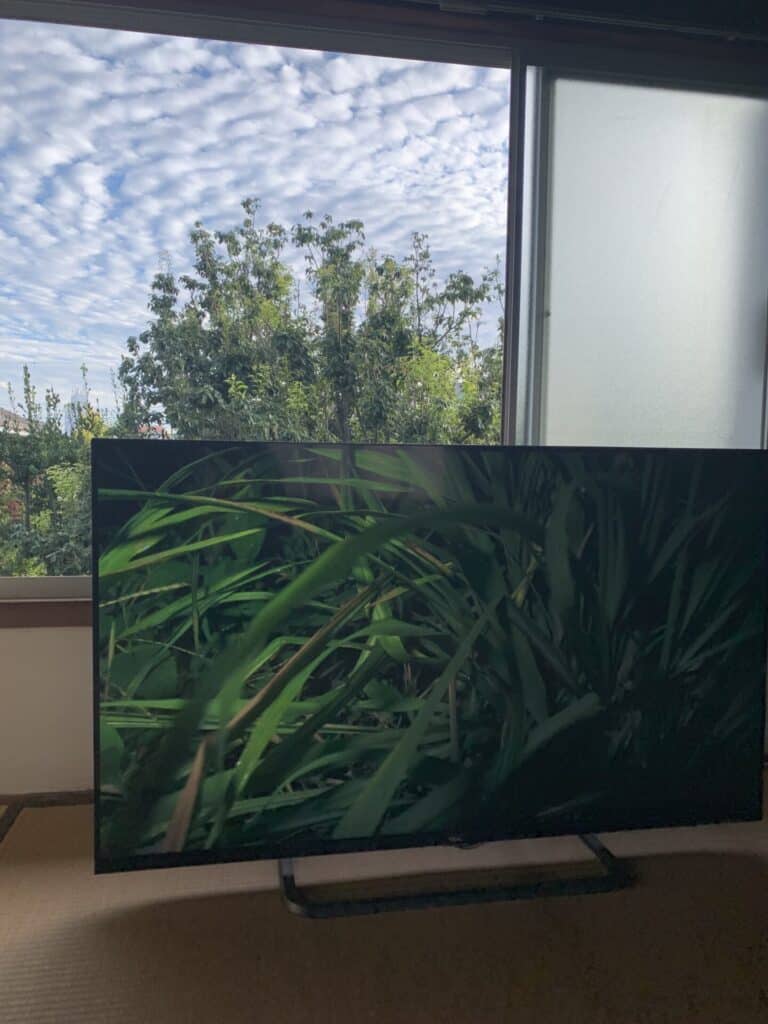

Mami notes that it is illegal to bring Vietnamese plants and vegetables abroad, and that Vietnamese refugees and immigrants find it difficult to come into contact with these nostalgic foods. Humans, animals, and plants have moved together in mutual support throughout human history, so why is this not allowed in modern times? During the colonial period, the Western world made its fortunes by importing and exporting plants such as sugarcane, and by the slave trade. Also, due to past colonial rule and the Vietnam War, the Vietnamese people, who did not want to move and disperse, have been driven to the margins of the world. Under such circumstances, I think that Mami is quietly telling us why we cannot access the “food” that is in our roots, and whether the current system of controls is really correct, as it ultimately won’t work.
Indeed, “to have roots” is the most important desire of the human soul. How should we go beyond or go back to a “root” that had been cut off from re-growth? French curator Nicolas Bourriaud (1965-) advocates the concept of “radicant” art. “Radicant” is like Kumagusu’s thought, and does not emphasize simply extending the tips of taproots and lateral roots. In other words, being a radicant is a movement to re-root one’s roots in a foreign context. For example, human beings are immigrants, exiles, urban wanderers, and plants, like ivy, do not cling to their taproot, but rather spread their roots in all directions from the surface they touch. This means re-rooting after movement, even if the root is sometimes cut [Briaud 2022: 70, 71].
I believe that the Vietnamese immigrants and the plants that “keep cultivating while moving” teach us strength to overcome the problems of modern systems and disciplines. At the same time, it should be noted that citrus farmers also do the work of “stretching the roots sideways” every day. Isn’t it a very suggestive fact that so-called “delicious mandarin oranges” will not be born simply by extending the roots underground?
With this in mind, I would like Mami to come to the Kinan/Kumano region, to hold dialogues with citrus farmers and Vietnamese immigrants, and to create new expressions while growing plants at the Commons Farm. Taro Okamoto advocated, “investing in a moment, something that is lifelike but non-artistic,” even if our challenge is criticized as being non-artistic, I would like to cultivate plants, citrus fruits, and their roots that are directly connected to our daily life, like an “orange mandala,” like “magic (art).”
In addition, SOUZOU held a painting workshop “Minakataru” by artist Naoko Kinemura. Based on the detailed specimen drawings left by Kumagusu Minakata, children from the community mixed up the descriptions of the plants collected in the garden of SOUZOU, adding (sometimes fictitious) explanations and annotations. We provided a painting experience for them to enjoy. By using paper that has been moistened with citrus juice and toasted, the participants created a unique Kumagusu world that transcends the passage of time, in an attempt to recapture the overall picture of the ever-changing plants.
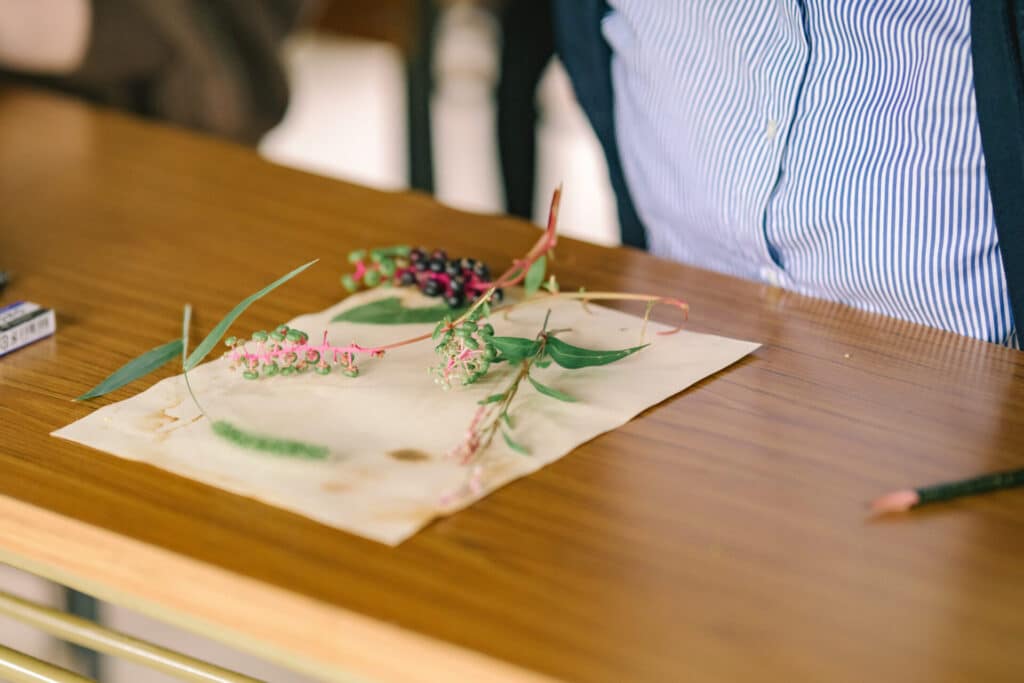
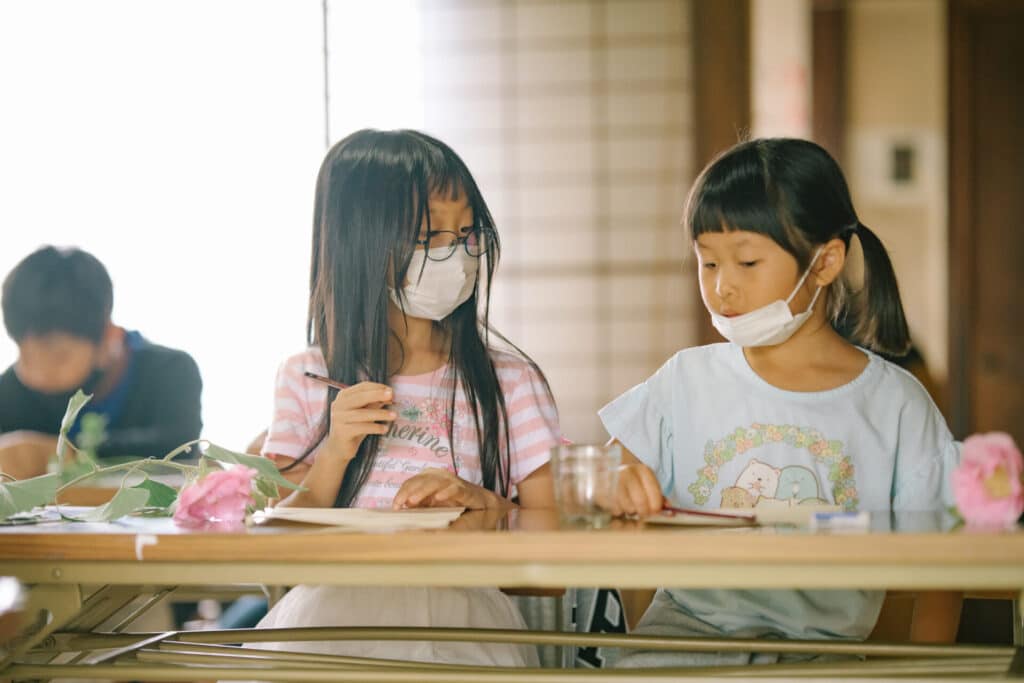
Furthermore, in collaboration with Wakayama Scholab, which aims to establish an exploratory bilingual elementary and junior high school in Wakayama, we held a parent-child workshop entitled “Orange Class” at Akizuno Garten and Kashiwagi Farm. Wakayama Scholab explores, practices, and collaborates with Wakayama’s nature, hometown, and climate starting with keywords such as “exploratory learning,” “learning about food,” “experiencing nature and culture,” and “global and local perspectives.” In the Orange class, we visited the field of a mandarin orange farm and held a workshop where parents and children could learn together and deepen their inquiry. After conducting fieldwork in a nearby mandarin orange field to explore the presented themes, the participants were divided into adult and child teams and held workshops using mind maps. Finally, we presented each other’s research results and tried to share deeper learning.
3 Where is an Orange that Transcends Fundamental Principles?
Finally, I think that it will naturally take time to produce “mandarin oranges that surpass principles.” Specifically, I believe that there is no choice but to build up fundamental dialogues and expressions that include other invisible things such as the vegetation, root networks, soil and myths behind the “mandarin orange.” With this “Mikan Mandala” exhibition as a trigger, we explored not only art but also other fields such as mythology, philosophy, anthropology, botany, ecology, design, etc. I would like to find a new collective intelligence, a mandala with the cosmic expanse that I have found in “mandarin oranges”.
For that, we need the power of contemporary artists. To return to Coccia’s words, contemporary art is an exercise that is not regulated by disciplinary rules, but rather cleaves through them. By shaking its assumptions, all of society itself can start to visualize things that could not be imagined, thereby creating a movement that makes it possible for culture and society to become different from the status quo. I think it is important that this is not a doctrine or thought, but a concrete movement. Hirose’s carpet-like “Mikan Mandala” is surely the start of a journey to find a place where all life forms are connected and can gather. It is exactly as what Kumagusu called the “萃点-suiten,” meaning “gathering point’,’ of many sorts of things overlapping as well as the point where various “kotowari – principles”’ pass through and intersect. This is Nakazawa’s idea of “re-editing, from a consistent perspective, the activities of the mind in a vast area ranging from religion to economics, science to art,” and transcending existing principles. I think it will all be connected.
Based on mandarin oranges and concepts from art anthropology, the Mikan Collective is a concrete art movement that mixes and transcends contradictions such as “opening/holding” and “bearing/rooting.” Now, why don’t we spend some time together searching for “mandarin oranges that transcend principles”?
<Reference list>
・Ando, Reiji. “Jomon Theory.” Sakuhinsha. 2022. [Translated from Japanese.]
・Bourriaud, Nicoas. ”Radicant. Pour une esthétique de la globalisation.” Translated by Hironari Takeda. Film Art. 2022.
・Burgat, Florence. “Qu’est-ce qu’une plante ? – Essai sur la vie végétale.” Translated by Yuko Tanaka. Kawakado Shinsha. 2021.
・Coccia, Emanuele. “Plant Life Philosophy: A Mixed Metaphysics.” Keiso Shobo. 2019. [Translated from Japanese.]
・Coccia, Emanuele. “Philosophy of Metamorphose.” Keiso Shobo. 2022. [Translated from Japanese.]
・Fujihara, Tatsushi. “Thoughts on Plants.” Ikinobirubooks, Ikinobirubooks, 6 Sept. 2021. https://ikinobirubooks.jp/series/fujihara-tatsushi/378/.
・Hyman, Clarissa. “Orange History.” Hara Shobo. 2016. [Translated from Japanese.]
・Ingold, Tim. “Living Moves, Knows, Writes” Translated by Tetsushi Nakano, et al. Sayusha. 2021. [Translated from Japanese.]
・Ishikura, Toshiaki & Karasawa, Taisuke. “Anthropology of Viscera and Co-Mutants.” EKRITS, EKRITS, 24 Dec. 2020, https://ekrits.jp/2020/12/3980/. [Translated from Japanese.]
・Jung, Carl Gustav. “Individuation and Mandalas.” Misuzu Shobo, Ltd. 1991. [Translated from Japanese.]
・Miki, Shigeo. “Fetal World.” Chuko Shinsho. 1983. [Translated from Japanese.]
・Montgomery, David & Bikle, Anne. “The Hidden Half of Nature The Microbial Roots of Life and Health.” Translated by Natsumi Katooka. Tsukiji Shokan Publishing., Inc. 2016.
・Mori, Motonao. “Introduction to Anarchism.” Sjolima Shobo. 2017. [Translated from Japanese.]
・Nakazawa, Shinichi. “Gift of Pure Nature.” Serica Syobo, Inc. 1996. [Translated from Japanese.] ・Nakazawa, Shinichi. “Art Anthropology.” Misuzu Shobo, Ltd. 2006. [Translated from Japanese.]
・Nakazawa, Shinichi. “Symmetrical Anthropology,” Kodansha Ltd. 2008. [Translated from Japanese.]
・Nakazawa, Shinichi. “Jung and the Mandala.” Edited by The Japan Association of Jungian Psychology. 2010. [Translated from Japanese.]
・Nakazawa, Shinichi. “Oriental.” Kodansha Gakujyutu Bunko. 2012. [Translated from Japanese.]
・Nakazawa, Shinichi & Ozawa, Minoru. “Dive into the Sea of Haiku.” Kadokawa. 2016.[Translated from Japanese.]
・Mancuso, Stefano & Viola, Alesandra. “Verde Brillante―Senaibilità e Intelligenza del Momd Vegtale.” Translated by Koji Kubo. NHK Publishing, Inc. 2015.
・Okuno, Katsumi et al. “ Anthropology of Humans and Animals.” Shumpusha Publishing. 2012. [Translated from Japanese.]
・Okamoto, Taro. “Mysterious Japan.” Kadokawa Sophia Bunko. 2015. [Translated from Japanese.]
・Pierre Laszlo. “Culture of Citrus Fruits.” Translated by Tomoko Teramachi. Ittosha Incorporated. 2010. [Translated from Japanese.]
・Weil, Simone. “Having Roots (1)” Iwanami Shoten,Publishers. 2010. [Translated from Japanese.] Yabumoto, Yuto. “Orange Collective: From Mikan and Spiritual Traditions in the East, to the Orange in the Global Market.” Kinan Art Week, Kinan Art Week, 21 Feb. 2022, https://kinan-art.jp/en/info/5778/.
・Yabumoto, Yuto. “The Myth of the Orange.” Kinan Art Week, Kinan Art Week, 22 May 2022, https://kinan-art.jp/en/info/6987/.
・Yabumoto, Yuto. “The “Place” of Kinan -Modernism and Animism-.” Official Catalog for Kinan Art Week Exhibition 2021. Kinan Art Week. 2022.
・Yabumoto, Yuto. “Archived Text (First Half) of Kinan Chemistry Session Vol.2 ‘Seclusion and Openness: Kumagusu Minakata, the Giant of Knowledge and Contemporary Art.’” Kinan Art Week, Kinan Art Week, 13 July 2021, https://kinan-art.jp/en/info/937/.
・Yamamoto, Tetsuji. “Kojiki and the Theology of the Country: The Beginning of Japan and Place Myths.” EHESC. 2022. [Translated from Japanese.]
・Yoritomi, Motohiro. “Esotericism and Mandala.” Kodansha Ltd. 2014. [Translated from Japanese.]
